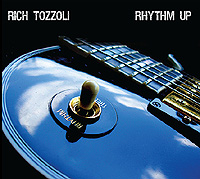 A
guitarist on a mission, N.J. based Rich Tozzoli comes alive
on the 2010 release of Rhythm Up. Featuring Tozzoli
firing on all cylinders in the studio, the ten track Rhythm Up
features Tozzoli on both electric lead and acoustic finger-style
guitar tracks, getting primo backup from a number of players including
a round of top drummers in Ray Levier and Shawn Pelton.
Also kicking in fresh energy is engineer and album co-producer / drummer
and all around electronics wizard Vincent Miraglia. Tozzoli’s
sound is clearly instrumental rock based fusion although several of
the acoustic guitar flavored tracks are really atmospheric and the
sonic grandeur of track seven “Palisades Parkway” is a definite
keeper. Fans of stately guitar instrumentals from giants like Hank
Marvin and Sandals fretboard genius John Blakeley should hunt this
CD down. There’s also a good Steve Morse comparison knockin'
around in there. With his nimble fretboard touch, Tozzoli’s calling
card as a top guitarist, producer, mixer, composer and sound designer
is no doubt shaped by his love of the fine guitars and vintage amps
in abundance here. Decked out in fine digi-pak design, the CD sound
is also enhanced by additional string arrangements by David Henry
capped off by mastering at NYC’s fabled Sterling Sound. An amazing
sounding, state of the art sounding instrumental jazz-rock fusion
album that will blow you away, Rhythm Up yields some very positive
musical results indeed. MWE3.com proudly presents Rich Tozzoli - Guitars
Center Stage. www.RichTozzoli.com
A
guitarist on a mission, N.J. based Rich Tozzoli comes alive
on the 2010 release of Rhythm Up. Featuring Tozzoli
firing on all cylinders in the studio, the ten track Rhythm Up
features Tozzoli on both electric lead and acoustic finger-style
guitar tracks, getting primo backup from a number of players including
a round of top drummers in Ray Levier and Shawn Pelton.
Also kicking in fresh energy is engineer and album co-producer / drummer
and all around electronics wizard Vincent Miraglia. Tozzoli’s
sound is clearly instrumental rock based fusion although several of
the acoustic guitar flavored tracks are really atmospheric and the
sonic grandeur of track seven “Palisades Parkway” is a definite
keeper. Fans of stately guitar instrumentals from giants like Hank
Marvin and Sandals fretboard genius John Blakeley should hunt this
CD down. There’s also a good Steve Morse comparison knockin'
around in there. With his nimble fretboard touch, Tozzoli’s calling
card as a top guitarist, producer, mixer, composer and sound designer
is no doubt shaped by his love of the fine guitars and vintage amps
in abundance here. Decked out in fine digi-pak design, the CD sound
is also enhanced by additional string arrangements by David Henry
capped off by mastering at NYC’s fabled Sterling Sound. An amazing
sounding, state of the art sounding instrumental jazz-rock fusion
album that will blow you away, Rhythm Up yields some very positive
musical results indeed. MWE3.com proudly presents Rich Tozzoli - Guitars
Center Stage. www.RichTozzoli.com
MUSIC WEB EXPRESS 3000
presents RICH TOZZOLI
Guitars Center Stage
Guitarists making waves in the music world,
their new recordings and gear!
Musical Background
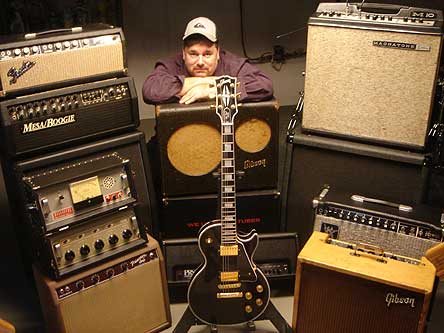 I've
been playing both acoustic and electric since I was 14 or 15. I had
this tiny little Yamaha acoustic guitar that I bought at the local
music store – that was my first taste. After getting further
into it, I picked up my first Tobacco Les Paul Standard when I was
like 16, a guitar I still record with to this day. I studied with
different teachers, from reggae to jazz to funk to R&B. I loved
learning new grooves – I’m essentially a groove player,
but enjoy melodic soloing as well.
I've
been playing both acoustic and electric since I was 14 or 15. I had
this tiny little Yamaha acoustic guitar that I bought at the local
music store – that was my first taste. After getting further
into it, I picked up my first Tobacco Les Paul Standard when I was
like 16, a guitar I still record with to this day. I studied with
different teachers, from reggae to jazz to funk to R&B. I loved
learning new grooves – I’m essentially a groove player,
but enjoy melodic soloing as well.
I played in different kinds of bands, including cool funk bands with
full horn sections and the works. I’ve also played in reggae
bands and rock bands, but always did original material.
I always had a fascination with the bass, and have been playing that
for many years as well. There’s something about carrying the
bottom of the mix that a guitar can’t do. I love the sound of
old Fender basses, and I actually put down the guitar for a few years
just to play bass in a band. But to be a good bass player, you have
to loose the guitar mentality and focus on the J.P. Jones and Jamersons
of the world. You also have to learn to get that tone with the fingers
that a pick can’t get.
Another aspect of my musical background is that I’ve spent a
lot of time on the other side of the glass recording, composing, mixing
and producing. I was fascinated with music technology and digital
recording before Pro Tools came out. I’ve always believed in
investing in good, high-end gear, and really learning how to use it.
I had one of the first Pro Tools rigs around, and that was when 16
channels cost 16 grand!
So I really got into Pro Tools and even went out on the road with
Emerson, Lake & Palmer at one point with my rig. I still remember
Greg Lake coming up to me in his accent saying ‘Richard, show
me this Pro Tools thing!’ Too funny…. Then I got deeply
into 5.1 Surround Sound production. I was able to mix projects ranging
from David Bowie and Billy Squire to Blue Oyster Cult and Hall &
Oates – who we got a Grammy nomination for this year along with
engineer Pete Moshay.
But capturing killer guitar tones was always my calling. I’ve
done a lot of work with guys like Al DiMeola, and also recorded a
lot of Ace Frehley’s last record. I can’t say enough about
how much I’ve learned from engineering and mixing for guys like
Al, Billy and Ace. I’ve been blessed to sit next to sit next
to some amazing guitar players and get their sound on ‘tape’.
But from those experiences, you learn about style, tone, approach,
technique and attitude just by being there with them for so many hours.
New
CD
Rhythm
Up was made spontaneously. It was really inspired by picking up
a Black Les Paul Custom that came from the Gibson Custom Shop. It
was like a light went on above me – the tone, neck, feel and
attitude of the guitar were so ‘me’. I was so into the sound
that guitar got through my amps, that I just said ‘its time to
make a record’.
I also came to realize that I’d composed and played on literally
hundreds of TV tracks, done lots of other people’s guitar records,
but never put something out of my own. The songs just came to me out
of nowhere, except I did re-record two TV cues that I thought were
cool.

So literally within days of deciding to make the record, I was up
at Clubhouse Studios in Rhinebeck, NY tracking with drummer Ray Levier.
Engineer/owner Paul Antonell dialed up some killer drum sounds in
the big room using his array of old mics through the vintage Neve
– an amazing board. I’d end up heavily compressing the room
mics later at the mix stage - part of what helps give that big drum
sound that can stand up to the guitars.
Then it was back home to my studio where I worked out my guitar parts.
But to really capture the amp sounds, I recorded at The Lab with Vincent
Miraglia, who I’ve known since middle school! He co-produced
the record with me, and he happens to be a great amp designer / tech,
engineer and tube guru.
We used a Royer 121 ribbon, Sennheiser 421’s and ‘57s to
get the amp tones, mostly through a Focusrite ISA 428. But we also
used a Universal Audio LA610, Earthworks 1024 and a cool dog called
a Magnasync – an old tube film dubber with a dark, vibey sound.
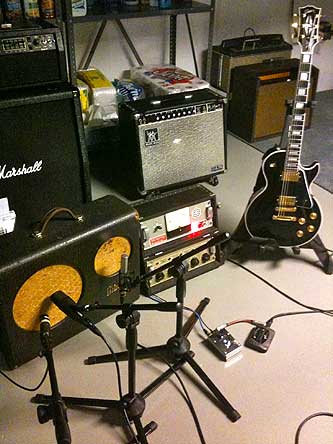 I
tend to record guitar, cable, and amp, as it always gets the best
tone. But I’d often use the Creation Audio Labs MK.4.23 Boost
Pedal, which provides clean gain to the amp. We’d drive the input
stage and it really creates a razor sharp attack to each note.
I
tend to record guitar, cable, and amp, as it always gets the best
tone. But I’d often use the Creation Audio Labs MK.4.23 Boost
Pedal, which provides clean gain to the amp. We’d drive the input
stage and it really creates a razor sharp attack to each note.
So we dialed in an arsenal of amps that we referred to as the “Whack
Stack”. He had a ‘64 Bassman head, a ‘64 Princeton
and a ’47 Gibson GA-25. I had my ’66 Magnatone M10A, ’62
Gibson Falcon, ’47 Gibson BR-6, ’91 Mesa Boogie MK IV and
an ’81 Music Man 112RD. We also had a 4X12 Marshall and a 4X12
Boogie cab.
Depending on what the song needed, we’d mix and match amps and
cabinets. He would sometimes tube swap, bias the amps hot, and we’d
just play and listen. I could feel the attack change with certain
tubes, as well as the type of crunch they’d provide. Different
brands of the same tubes really are different! If we hit on something,
we’d track it immediately.
Since it was a guitar record, we spent a lot of time getting the amps
right. There’s no doubt that driving tube amps hot and loud changes
how you hit the strings, and ultimately that comes across through
the mics. Magnatones don’t sound like Gibsons, which don’t
sound like Fenders. So we’d use whatever worked best for the
song.
On a few songs, I worked with drummer Shawn Pelton at his studio in
New York City. I also had the late great T Bone Wolk come in and play
bass on a few cuts, as did Brian Mackewich and fretless player Joe
Capozio. On the song “Bed of Coals”, which Joe played on,
Lee Baronian and Dave Hull did some cool Middle Eastern percussion
and Andy Munitz played violin. Vincent Miraglia also played percussion
and drums on that tune. It was a tough one to mix!
Part of what I was also going for on this record was to expand my
orchestration chops – something I continue to study with several
teachers. On a few songs, I’d compose the string parts for cello
and viola in Pro Tools, then using FTP, upload the files, midi notes,
and music to David Henry in Nashville. He would then record the parts
down there, and FTP them back to me as a Pro Tools session. Of course,
he would add in his own touch. My parts would be a guide for him to
work from, as you can’t beat letting a talented string player
do what they do best. That actually applies to any great player –
let them do their thing! But I learned a lot from listening to what
he did with my basic ideas. Studying orchestration can also really
help with the arrangement of guitar ideas – especially on acoustic
pieces that breathe.
Since I’ve also done a lot of work with the great flamenco guitarist
Hernan Romero, he laid down a beautiful part on the acoustic song
“Over The Horizon”. He has an amazing tone and technique,
and I used 2 Earthworks QTC-1 mics and a DPA 4099 clip on mic, all
through the Earthworks 1024 preamp to capture his sound.
I used my Guild F50 on that song, capoed on the 3rd fret. I played
all the acoustic songs on the record in DADGAD, and also used my Guild
D66 Gruhn model, Guild JF4-12 12 string and a Hi String guitar. All
the acoustic guitars were recorded with the Earthworks/DPA combination,
some at my studio and some at The Lab. There’s actually three
acoustic cuts on Rhythm Up, which - production wise, also helps
to give the ear a break.
Slide master Sam Broussard, from Lafayette, LA. also guested on the
song “Stinkpot.” He’s one hell of a player, and like
David Henry, cut his parts down at his studio, sending them back via
FTP when finished.
So assembling all the tracks, I mixed the record back at my studio
on my Pro Tools HD rig. For mastering, I took it to Chris Athens at
Sterling Sound in New York. Then it was done! I’d done the whole
record from its first idea to completion in just a few months. I had
so much fun making it I’m ready to do another.
Favorite
Guitars
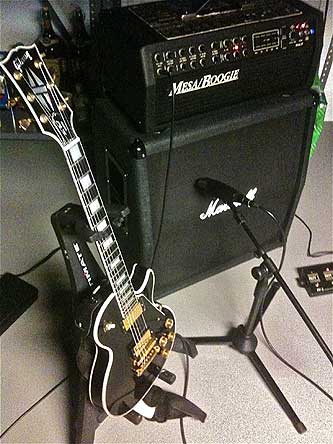 I've
always been a Les Paul guy at heart. To me, its about that thick,
nasty tone and sustain that no other guitar can get. So I have my
old Tobacco Standard, as well as the main guitar from Rhythm Up,
the black Les Paul Custom. They both have very hot pickups in them,
DiMarzios in the Standard and Gibson 490R’s and 498T’s in
the Custom.
I've
always been a Les Paul guy at heart. To me, its about that thick,
nasty tone and sustain that no other guitar can get. So I have my
old Tobacco Standard, as well as the main guitar from Rhythm Up,
the black Les Paul Custom. They both have very hot pickups in them,
DiMarzios in the Standard and Gibson 490R’s and 498T’s in
the Custom.
But funny enough, when I play out, it’s mainly my American Standard
Tele, which I bought at Matt Uminov’s in NYC a long time ago.
Tele’s can funk and groove and be smooth, but they fight you
too – a good thing when playing hard rhythms. I used that on
the song “Driven” through the Bassman head. Can’t go
wrong with that combo.
I have all my Guild acoustics, and just picked up both a jumbo Guild
F512 and a beautiful Martin 000-18 Norman Blake with a 12-fret neck
and Mahogany back and sides. New guitars inspire new tracks.
As for basses, I played my ‘70 Precision on a few Rhythm Up
tunes, and Joe Capozio played my ’77 Precision fretless –
both of which are strung up with DR’s. They both went through
the Creation Audio Labs MW1 Studio Tool direct into Pro Tools, where
I’d add some compression and filter out some bottom.
Since I do a lot of TV music, I also have a Strat customized by Don
Mare, a Fender Jaguar Baritone, a high string, and so on. All my guitars
are strung up with D’Addario strings, and I prefer Phosphorous
Bronze for the acoustics, and Light Top/Heavy Bottom nickel wound
XLs on the electrics. I have to say, I owe a lot to Rob DiStefano
at Fret Tech, who keeps them all tuned up and happy.
I have a lot of guitars, but I really do use them all.
Musical
Influences
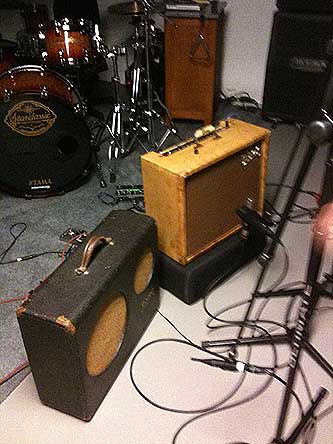 Kiss
got it all started for me, with Alive and Alive II.
Then I naturally gravitated to Zeppelin, Aerosmith and Pink Floyd.
From there I got into Yes and Genesis, then came across The Allman
Brothers, Jeff Beck and Rush. I was drawn to anybody who had a unique
sound and style.
Kiss
got it all started for me, with Alive and Alive II.
Then I naturally gravitated to Zeppelin, Aerosmith and Pink Floyd.
From there I got into Yes and Genesis, then came across The Allman
Brothers, Jeff Beck and Rush. I was drawn to anybody who had a unique
sound and style.
I was inspired by the style and approach of the players I listened
to, not the exact notes. It was a very creative time to learn guitar,
as you had the aggression of Page and Perry with the odd times and
precision of Lifeson, the fusion of Beck or the blues of Betts/Allman.
I became a really strong rhythm player, but could always wail out
a lead if I wanted to.
Funny thing is, growing up I never really learned to play the songs
of the bands I loved listening to, as my friends and I always played
our own music, or just jammed on jazz progressions. The great thing
is, I still jam with those same friends all these years later. Many
of us, myself included, still have the same guitars – you gotta
love that!
To this day though, I’m still really glad we would just make
up songs, as I can creatively bang out a TV track literally in minutes.
Funny, people always say “play a song I know”, and I’m
always like, “I don’t know any!”!
Upcoming
Plans
I’ve been working on a new all acoustic CD, and doing
a cool project called The Deep Dig with guitarist/producer Scott E.
Moore. It’s like groovy film music with vibey guitar sounds.
I might be heading out on the road to Europe with Hernan Romero in
the fall – but we’ll see. For now, I’m having fun doing
other peoples records composing TV tracks. I just wish I didn’t
have to change strings so often!
Web Site
My website is RichTozzoli.com
and you can get me there!



 A
guitarist on a mission, N.J. based Rich Tozzoli comes alive
on the 2010 release of Rhythm Up. Featuring Tozzoli
firing on all cylinders in the studio, the ten track Rhythm Up
features Tozzoli on both electric lead and acoustic finger-style
guitar tracks, getting primo backup from a number of players including
a round of top drummers in Ray Levier and Shawn Pelton.
Also kicking in fresh energy is engineer and album co-producer / drummer
and all around electronics wizard Vincent Miraglia. Tozzoli’s
sound is clearly instrumental rock based fusion although several of
the acoustic guitar flavored tracks are really atmospheric and the
sonic grandeur of track seven “Palisades Parkway” is a definite
keeper. Fans of stately guitar instrumentals from giants like Hank
Marvin and Sandals fretboard genius John Blakeley should hunt this
CD down. There’s also a good Steve Morse comparison knockin'
around in there. With his nimble fretboard touch, Tozzoli’s calling
card as a top guitarist, producer, mixer, composer and sound designer
is no doubt shaped by his love of the fine guitars and vintage amps
in abundance here. Decked out in fine digi-pak design, the CD sound
is also enhanced by additional string arrangements by David Henry
capped off by mastering at NYC’s fabled Sterling Sound. An amazing
sounding, state of the art sounding instrumental jazz-rock fusion
album that will blow you away, Rhythm Up yields some very positive
musical results indeed. MWE3.com proudly presents Rich Tozzoli - Guitars
Center Stage.
A
guitarist on a mission, N.J. based Rich Tozzoli comes alive
on the 2010 release of Rhythm Up. Featuring Tozzoli
firing on all cylinders in the studio, the ten track Rhythm Up
features Tozzoli on both electric lead and acoustic finger-style
guitar tracks, getting primo backup from a number of players including
a round of top drummers in Ray Levier and Shawn Pelton.
Also kicking in fresh energy is engineer and album co-producer / drummer
and all around electronics wizard Vincent Miraglia. Tozzoli’s
sound is clearly instrumental rock based fusion although several of
the acoustic guitar flavored tracks are really atmospheric and the
sonic grandeur of track seven “Palisades Parkway” is a definite
keeper. Fans of stately guitar instrumentals from giants like Hank
Marvin and Sandals fretboard genius John Blakeley should hunt this
CD down. There’s also a good Steve Morse comparison knockin'
around in there. With his nimble fretboard touch, Tozzoli’s calling
card as a top guitarist, producer, mixer, composer and sound designer
is no doubt shaped by his love of the fine guitars and vintage amps
in abundance here. Decked out in fine digi-pak design, the CD sound
is also enhanced by additional string arrangements by David Henry
capped off by mastering at NYC’s fabled Sterling Sound. An amazing
sounding, state of the art sounding instrumental jazz-rock fusion
album that will blow you away, Rhythm Up yields some very positive
musical results indeed. MWE3.com proudly presents Rich Tozzoli - Guitars
Center Stage.  I've
been playing both acoustic and electric since I was 14 or 15. I had
this tiny little Yamaha acoustic guitar that I bought at the local
music store – that was my first taste. After getting further
into it, I picked up my first Tobacco Les Paul Standard when I was
like 16, a guitar I still record with to this day. I studied with
different teachers, from reggae to jazz to funk to R&B. I loved
learning new grooves – I’m essentially a groove player,
but enjoy melodic soloing as well.
I've
been playing both acoustic and electric since I was 14 or 15. I had
this tiny little Yamaha acoustic guitar that I bought at the local
music store – that was my first taste. After getting further
into it, I picked up my first Tobacco Les Paul Standard when I was
like 16, a guitar I still record with to this day. I studied with
different teachers, from reggae to jazz to funk to R&B. I loved
learning new grooves – I’m essentially a groove player,
but enjoy melodic soloing as well. 
 I
tend to record guitar, cable, and amp, as it always gets the best
tone. But I’d often use the Creation Audio Labs MK.4.23 Boost
Pedal, which provides clean gain to the amp. We’d drive the input
stage and it really creates a razor sharp attack to each note.
I
tend to record guitar, cable, and amp, as it always gets the best
tone. But I’d often use the Creation Audio Labs MK.4.23 Boost
Pedal, which provides clean gain to the amp. We’d drive the input
stage and it really creates a razor sharp attack to each note.  I've
always been a Les Paul guy at heart. To me, its about that thick,
nasty tone and sustain that no other guitar can get. So I have my
old Tobacco Standard, as well as the main guitar from Rhythm Up,
the black Les Paul Custom. They both have very hot pickups in them,
DiMarzios in the Standard and Gibson 490R’s and 498T’s in
the Custom.
I've
always been a Les Paul guy at heart. To me, its about that thick,
nasty tone and sustain that no other guitar can get. So I have my
old Tobacco Standard, as well as the main guitar from Rhythm Up,
the black Les Paul Custom. They both have very hot pickups in them,
DiMarzios in the Standard and Gibson 490R’s and 498T’s in
the Custom. Kiss
got it all started for me, with Alive and Alive II.
Then I naturally gravitated to Zeppelin, Aerosmith and Pink Floyd.
From there I got into Yes and Genesis, then came across The Allman
Brothers, Jeff Beck and Rush. I was drawn to anybody who had a unique
sound and style.
Kiss
got it all started for me, with Alive and Alive II.
Then I naturally gravitated to Zeppelin, Aerosmith and Pink Floyd.
From there I got into Yes and Genesis, then came across The Allman
Brothers, Jeff Beck and Rush. I was drawn to anybody who had a unique
sound and style.